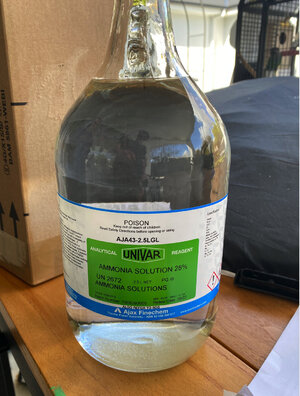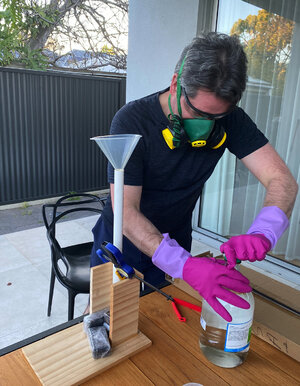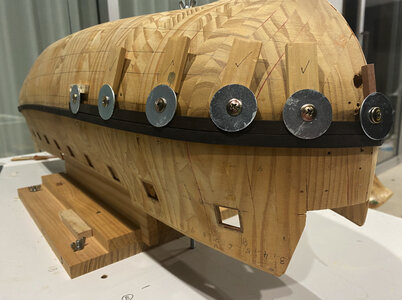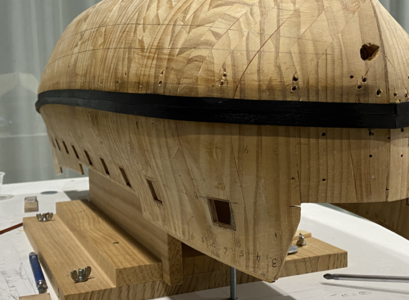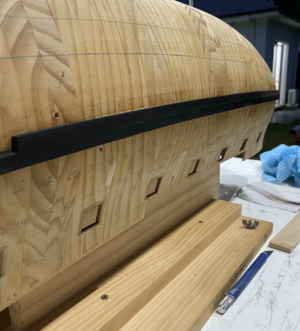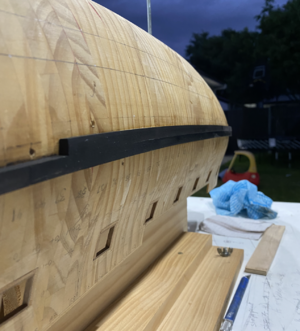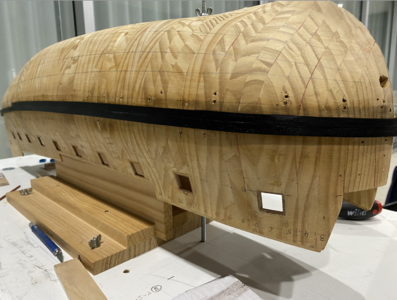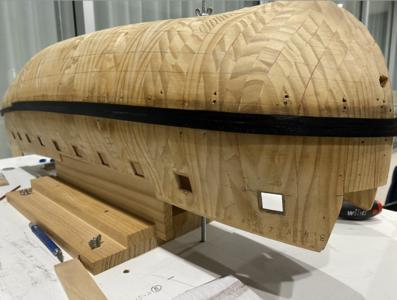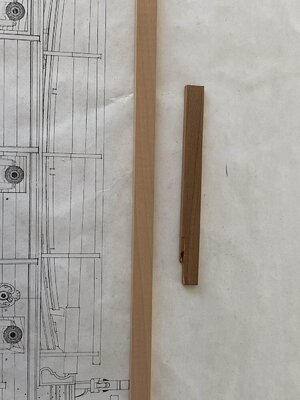-

Win a Free Custom Engraved Brass Coin!!!
As a way to introduce our brass coins to the community, we will raffle off a free coin during the month of August. Follow link ABOVE for instructions for entering.
-

PRE-ORDER SHIPS IN SCALE TODAY!
The beloved Ships in Scale Magazine is back and charting a new course for 2026!
Discover new skills, new techniques, and new inspirations in every issue.
NOTE THAT OUR FIRST ISSUE WILL BE JAN/FEB 2026
You are using an out of date browser. It may not display this or other websites correctly.
You should upgrade or use an alternative browser.
You should upgrade or use an alternative browser.
Le Mercure ANCRE Plans
- Thread starter LeMercure
- Start date
- Watchers 38
-
- Tags
- ancre le mercure
After removal from the Ammonia I clamp the piece to achieve the desired curve exactly. After 10 hours or so the wood then retains that shape permanently as a solid piece again. It is at that point that it is glued on to the model. As such, I wonder when the cell walls recover after the drying process. But again, I am guessing - this is not an area I know anything about.
I'd be keen to hear what you can find...
I'd be keen to hear what you can find...
- Joined
- Aug 8, 2019
- Messages
- 5,508
- Points
- 738

The only thing I could find on the WWW is that ammonia makes the cellular walls soft and flexible. And that you need a solution with a low concentration ammonia like Maarten said. Also that some kind of woods turn black by the use of ammonia. There was a person on another forum who says that ammonia destroys the cell walls, but I couldn't find proof about that.
Using ammonia is a good alternative when you can't use steam.
The only problem with ammonia is that it is a poison and dangerous to handle. And the terrible smell. Not something to do in the house.
What kind of solution do you use?
Using ammonia is a good alternative when you can't use steam.
The only problem with ammonia is that it is a poison and dangerous to handle. And the terrible smell. Not something to do in the house.
What kind of solution do you use?
I use a 28% solution purchased from a scientific shop (photo attached). I use it as is with no further dilution. The planks are soaked in a PVC pipe with capping on both ends.
I use a mask, gloves and eye protection.
I agree that the smell is horrible but with a respirator you eliminate a lot of it. I work outside.
Steam is certainly preferable (in terms of smell and handling etc) but you just don't get the same level of elasticity in the plank.
Only the planks at the bow will require this process. I think I'll use steam for the smaller bends.
I have no doubt the cell walls are weakened substantially which is what allows the bend but after drying the plank becomes hard again as if it was never soaked. I removed my test plank and it retained the exact shape with absolutely zero spring back. That is another difficulty with steam - you have to over bend to account for spring back and this is always a "best guess".
I include another photo of the actual plank I will attach next. It is drying to the shape of the hull after being removed from the Ammonia.
I use a mask, gloves and eye protection.
I agree that the smell is horrible but with a respirator you eliminate a lot of it. I work outside.
Steam is certainly preferable (in terms of smell and handling etc) but you just don't get the same level of elasticity in the plank.
Only the planks at the bow will require this process. I think I'll use steam for the smaller bends.
I have no doubt the cell walls are weakened substantially which is what allows the bend but after drying the plank becomes hard again as if it was never soaked. I removed my test plank and it retained the exact shape with absolutely zero spring back. That is another difficulty with steam - you have to over bend to account for spring back and this is always a "best guess".
I include another photo of the actual plank I will attach next. It is drying to the shape of the hull after being removed from the Ammonia.
Attachments
So waht we learnt today:
Using Ammonia, there will grow a third hand ......
Usually when I see you working with rubber gloves, gas mask, safety glasses and three hands it is really not easy,
but your description of the very positive result is telling us: Worth to try in special cases like the bow
Many Thanks for showing us the details and the explanations - Very interesting
Using Ammonia, there will grow a third hand ......
Usually when I see you working with rubber gloves, gas mask, safety glasses and three hands it is really not easy,
but your description of the very positive result is telling us: Worth to try in special cases like the bow
Many Thanks for showing us the details and the explanations - Very interesting
BTW: I hope your wife got also a mask like you had?!?
@Uwe - yes that third hand appearing was rather odd. 
Further on the Ammonia discussion, I sent Dr Mike the question about Ammonia causing problems with the wood. His response below (translated using DeepL from Russian to English):
The fears of our ship modelling colleagues are completely unfounded. Nitrate compounds are the basis of organic compounds. Urea treatment has been used for thousands of years in the production and processing of fabrics, leather, bone and wood. They are not acids or sulphur compounds. In their case there is a risk of formation of sulphuric acids when wet. This is the reason the Vasa museum ship in Sweden is now being destroyed.
Ammonia causes the resins contained between the fibres of the wood to soften and make them easier to shift when bent. It has no effect on the fibres themselves. We get the same effect by heating the wood with steam. The ammonia vapour evaporates quickly and the layers are cured in their new position. This is no different from heat treatment. In museums around the world, you can see many bent wooden or bone objects with a very long age.
Further on the Ammonia discussion, I sent Dr Mike the question about Ammonia causing problems with the wood. His response below (translated using DeepL from Russian to English):
The fears of our ship modelling colleagues are completely unfounded. Nitrate compounds are the basis of organic compounds. Urea treatment has been used for thousands of years in the production and processing of fabrics, leather, bone and wood. They are not acids or sulphur compounds. In their case there is a risk of formation of sulphuric acids when wet. This is the reason the Vasa museum ship in Sweden is now being destroyed.
Ammonia causes the resins contained between the fibres of the wood to soften and make them easier to shift when bent. It has no effect on the fibres themselves. We get the same effect by heating the wood with steam. The ammonia vapour evaporates quickly and the layers are cured in their new position. This is no different from heat treatment. In museums around the world, you can see many bent wooden or bone objects with a very long age.
Yes, it was a very interesting response suggesting it is not the fibre cells themselves that are destroyed but the resins between them.
Also, we do have articles of wood that are many many years old that remain in perfect condition after being subject to this process.
Also, we do have articles of wood that are many many years old that remain in perfect condition after being subject to this process.
I include a video showing how I glue a plank to the model after the plank has been shaped and formed. The vast majority of the work is in shaping and forming the plank so the process in the video is really just the finale. However, the gluing process is very important as you need to ensure there are absolutely no gaps or spaces between adjacent planks.
I must apologise - the background music is a little loud (and dramatic) and was playing on my speakers outside as I made the video. I have been working outside on my alfresco in the last few days as we have had very nice weather in Adelaide. I will be impressed if anyone can tell me the name of this piece of music...
I also attach some photos taken a few hours after the video with the clamps removed.
I must apologise - the background music is a little loud (and dramatic) and was playing on my speakers outside as I made the video. I have been working outside on my alfresco in the last few days as we have had very nice weather in Adelaide. I will be impressed if anyone can tell me the name of this piece of music...
I also attach some photos taken a few hours after the video with the clamps removed.
Attachments
I have worked very slowly over the last week or so but I have now finished planking the main wales.
Tonight, I gave them a very light sand with 120 grit paper. I still need to remove a further 1mm from them.
However, I won't do this until the pear under the wales has also been planked.
This is my next job....
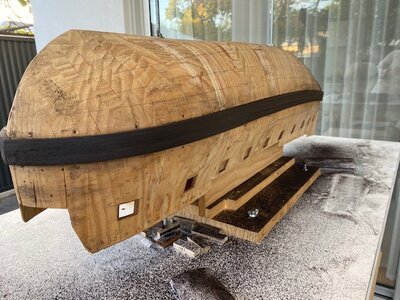
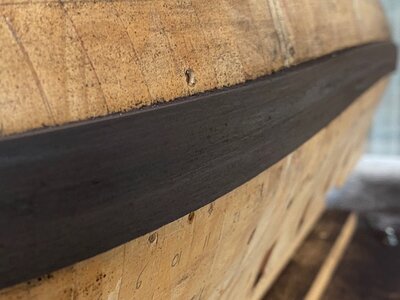
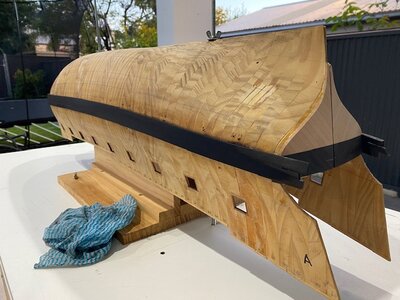
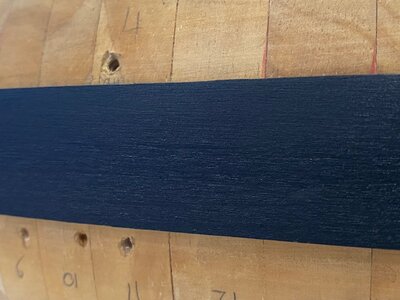
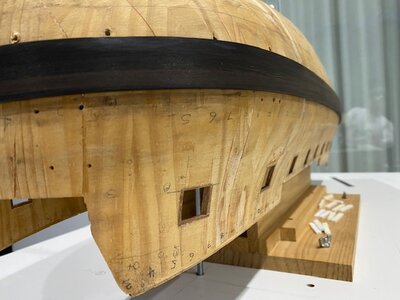
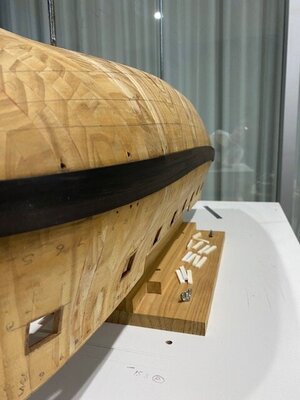
Tonight, I gave them a very light sand with 120 grit paper. I still need to remove a further 1mm from them.
However, I won't do this until the pear under the wales has also been planked.
This is my next job....






Now that you are on my radar, Antonio, I am thrilled to watch you construct the beautiful Mercure. Your work and attention to detail are superb!
Hello! It has been a while. Thank you Hubac's Historian!
I have made some progress and will post some photos shortly but in the interim, for those who are interested, I have performed an interesting experiment.
I include a photo of two pieces of Pear which have actually been cut from the same longer piece. As such, they were identical.
However, the shorter piece has been has been soaked in Ammonia for 12 hours as a test to see how the Ammonia might effect lighter coloured woods.
As you can see it has turned much darker.
This means I am unable to use Ammonia for any of the planking below the wales (where I will use Pear) unless I soak every Pear plank to ensure consistency (which I don't need or want to do).
As such, to preserve the lighter colour of the pear (which I like), I will use Steam for all planking of pear.
I have made some progress and will post some photos shortly but in the interim, for those who are interested, I have performed an interesting experiment.
I include a photo of two pieces of Pear which have actually been cut from the same longer piece. As such, they were identical.
However, the shorter piece has been has been soaked in Ammonia for 12 hours as a test to see how the Ammonia might effect lighter coloured woods.
As you can see it has turned much darker.
This means I am unable to use Ammonia for any of the planking below the wales (where I will use Pear) unless I soak every Pear plank to ensure consistency (which I don't need or want to do).
As such, to preserve the lighter colour of the pear (which I like), I will use Steam for all planking of pear.
Attachments
Does the oxidation lighten with sanding or has it completely permeated the wood fibers?
- Joined
- Oct 15, 2017
- Messages
- 1,190
- Points
- 443

Some how, I am just finding this build. I just admire the symmetry and finish in the planks of your transom plate. Wonderful work.My time in my workshop today was limited as I am preparing dinner for some guests!
However, I have managed to make progress on the stern pieces. They are not finished yet. They will require further sanding tomorrow, but not much.
Once they have been sanded I will glue them to the model and start the hull planking.
View attachment 258006
View attachment 258007
View attachment 258008
View attachment 258009
On another note, and I apologizes if this has already been asked. I am interested in perhaps using your "solid hull" method, but weight has always concerned me. Would you please let us know, in its current state of development, what the model weighs?
Thank you.
Ken.
Last edited:
@Steef - I have tried using Ammonia on several species of lighter woods and they all seem to darken. Dr Mike cautioned me about this some time ago but it is good to experience it first hand. He actually uses Ammonia to deliberately darker pear for use on other parts of the model.
@Hubac's Historian - The Ammonia has penetrated the fibres completely so the plank is dark through its entire thickness. Sanding won't fix this...
@Hoss6262 (Ken) - It is heavy! My best guess is approaching 10kg (22lb) so far. Please bear in mind the hull is almost 1m long.
@Hubac's Historian - The Ammonia has penetrated the fibres completely so the plank is dark through its entire thickness. Sanding won't fix this...
@Hoss6262 (Ken) - It is heavy! My best guess is approaching 10kg (22lb) so far. Please bear in mind the hull is almost 1m long.



